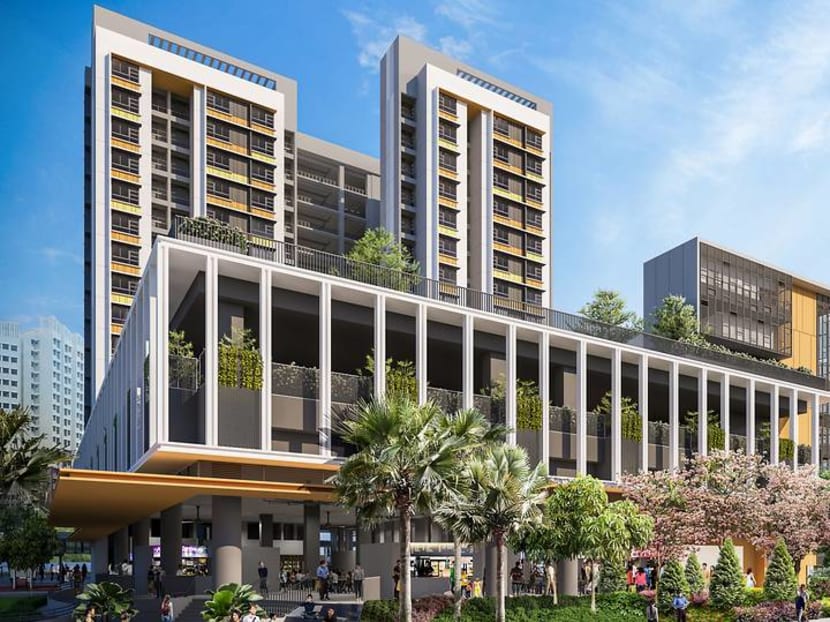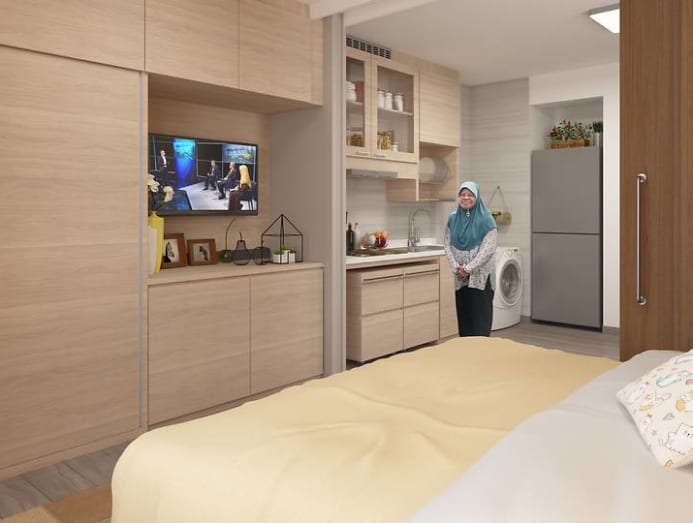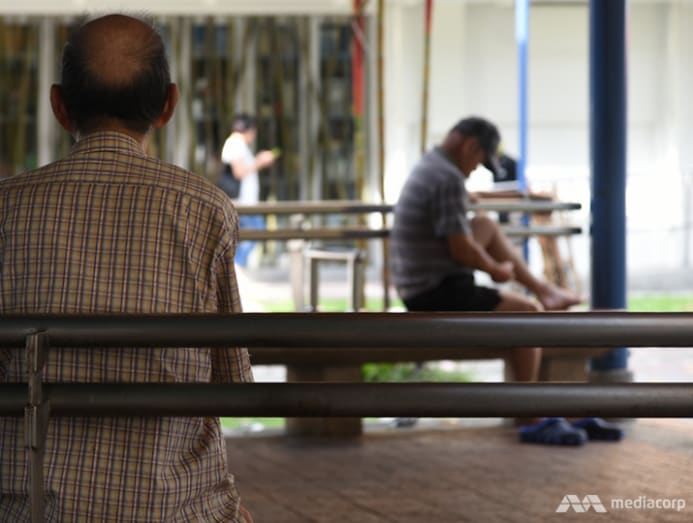commentary Commentary
Commentary: An elderly public housing project is a game-changer but mindsets still need shifting
It is still common to see ageing as negative and frailty-focused so the new assisted living units planned for construction in Bukit Batok has a chance to make growing older much more meaningful, says the CEO of the Tsao Foundation.

The Community Care Apartments in Bukit Batok will be integrated with a hawker centre, activity centre and community garden. (Photo: Housing & Development Board)
SINGAPORE: In his book, Being Mortal, author Atul Gawande writes movingly about the difference between an ageing person living out their final years in the comfort of home versus in an institution where all sense of self is eroded as they are treated like patients rather than people.
The launch of the public housing project to provide 160 assisted living units in Bukit Batok is a game changer much in line with how Gawande envisions ageing.
In offering older Singaporeans who need some amount of daily health assistance, but without the restrictions of institutionalised residential living of a nursing home, it is a step towards dignified ageing.
Seniors can purchase a lease of up to 35 years on a property bundled with a basic service package of health and social care, to which they can add other payable services as their care needs change.
READ: New flats for the elderly to be launched in February BTO exercise, with subscription to care services
A collaborative effort by two ministries and the Housing Development Board (HDB), the Bukit Batok concept is another step towards integrating the "hardware"- physical space - and "software"- basic services and community interaction - that are essential enablers of ageing in place and all-round healthier living.
Earlier projects like Kampong Admiralty and Heartbeat@Bedok offered older Singaporeans purpose-built public housing with co-located healthcare facilities and community spaces for enhanced ease of access, but those did not bundle home ownership with the delivery of domiciliary care services.
AN ESSENTIAL ADDITION
The Bukit Batok development introduces an entirely new but essential component into the country’s care eco-system at the health systems level, bringing the country on par with others like the US, where assisted living has long been part of long-term care options.
At the Tsao Foundation, which provides multidisciplinary care for home-dwelling elders, we have seen many older persons landing in nursing homes even when the assistance they actually needed was less than a nursing home’s scope of services and facilities.
Too often, this had been against their wishes to remain living at home, in the community most familiar to them.

It could happen when immediate or reliable help cannot be put into place for the elder, who could otherwise live independently, to take his essential medication, or adequately manage toileting and personal hygiene.
READ: Assisted living flats for seniors would plug gap in housing market, fulfil various needs: Experts
This trend has been somewhat mitigated by the burgeoning of intermediate- and long-term care services for home-dwelling elders, especially in the last three to five years.
This can be seen in the plethora of home- help services, home- care services, day centres and community-based care management services listed under the AIC’s Care Services pages.
ASSISTED LIVING HAS TO PASS A CRITICAL TEST
The development of assisted living facilities within public housing estates will certainly bolster the option to continue living at home despite frailty, and should help to thwart the painful — and resource-draining — "nursing-home-as-first-stop" track.
Yet, there is one critical test for the assisted living project: How successful will it be in delaying nursing home admission or cutting its inappropriate use?
By design, the project should be able to do both as it provides comprehensive home help services, home medical care and programmes to promote social and wellness activities over a resident’s life course, as well as the option to buy other services that they need on top of the basic package.
READ: Half of all new two-room HDB Flexi flats booked by elderly buyers; singles bought 38% of units
Nonetheless, assisted living cannot function as a standalone solution. Not only will the residents need care services from external providers, they might well spend bouts of time in other care settings such as stays at an acute hospital, or a community hospital for rehabilitative care or recuperation, or indeed, admission into the nursing home.
Given this, the relationships between the assisted living facility and other stakeholders working jointly in a seamless, integrated manner as the older person’s care partners are of critical importance to the health of its residents and its own success.

The extent of its capacity to provide a viable alternative between home and institutionalised care may well depend on the profile of the people it accepts into the project; how well it defines its deliverables and manages expectations; its own service quality, including service linkages; and cost efficiencies.
NOT ALLOWING ELDERLY “GHETTOS”
At both the societal and personal level, healthy ageing and the "good life" look beyond achieving just physiological wellness, important though it is.
We all strive to find meaning, make connection, participate and contribute at every stage of our lives: the continuing capacity to do these are the hallmark of successful ageing.
As such, any initiative to enable ageing-in-place must necessarily support and empower individuals and their community in these aspirations.
The Bukit Batok development tries to meet these needs by providing furnished communal spaces for its residents to gather, share a meal or participate in arranged activities as part of the basic service package.
READ: Commentary: It is high time for a Ministry on Ageing Issues
It remains to be seen whether the arranged activities include promoting connection with other Bukit Batok residents or facilitating the elders to become active members and leaders in the wider community.
However well-meaning it is, a building with 160 flats designed solely for the occupation of people above 65 raises the question of whether it will become an “elders ghetto”.
By this I mean the neighbourhood can become a space only for elders and professional caregivers. The void deck downstairs is likely to see wakes rather than other activities. Therefore, the connection to mainstream life is critical.
WHERE ELDERS HAVE A VOICE
The Tsao Foundation embarked on its ground-breaking project, the Community for Successful Ageing (ComSA) in Whampoa in 2013. There were three key components to this: An integrated care system that promotes the physiological, social and emotional health of the older person over the life course and across care settings.
A robust infrastructure that takes into account the built environment and linkages within and beyond Whampoa and finally, a community development programme that empowers older persons in their choices.
We start with the premise that connection and meaningful contributions are what lifts the human spirit and gives life to the daily grind.
Within its premises at the Whampoa Community Club, ComSA houses a primary healthcare clinic integrated with care management and counselling services, a day care centre and a training centre, all serving primarily older people — as well as a drop-in cafe, run by older persons, open to all.
READ: Commentary: You don’t have to age and grow frail alone. Nurses have your back
A key component of the ComSA is that it offers skills training and facilitates opportunities for older persons to speak up, lead and organise initiatives for themselves and their wider community.
This has resulted in, for instance, several roving exhibitions of their cherished heirlooms and family recipes as artefacts of Whampoa’s cultural legacy.
What we have learnt at ComSA is fundamental: It’s not which institutions you are near to but whom you can call and talk to that matters the most.
A care eco-system that works for the older person is one where he or she has the agency to make decisions and everyone around them – family members, care-givers, health professionals – all have strong relationships with them.
ComSA, after seven years, is still a work in progress, but those of us on the ground are ever more convinced of the critical need to facilitate and support connections and platforms whereby elders are consulted on what affects their own lives and where they live.
READ: Commentary: The future of Singapore housing is in bigger HDB flats
READ: Commentary: The Lease Buyback scheme can give singles more housing options
In just 10 years’ time, Singapore will have at least 25 per cent of its population aged 65 and above. Community-based care, as opposed to institutionalised living arrangements, is the lynchpin of the health ecosystem being developed and viable assisted living options will be a critical part of it.
Beyond building infrastructure and improving service capacity, there is urgent need to recalibrate how ageing and the older person are viewed, and to dedicate efforts to creating a society for all ages where elders thrive and more importantly, where they are allowed dignity and agency in their sunset years.
Peh Kim Choo is the CEO at the Tsao Foundation.





